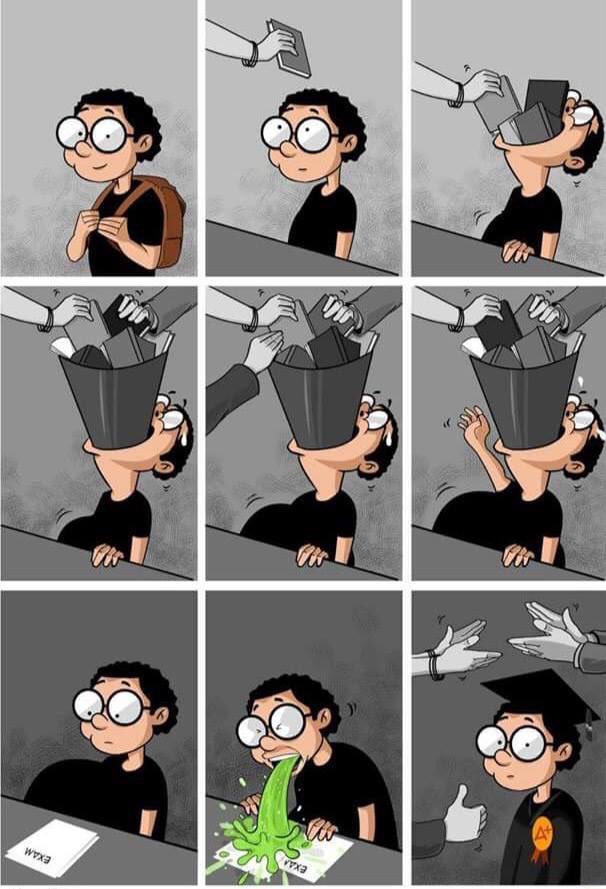This is the seventh of a series of posts about what Project Based Learning infused with Social and Emotional Learning looks like when teaching remotely. Is it the ideal situation? Probably not, but it is the reality that many of us are dealing with. I will share my ideas and what others are doing to hopefully inspire you to action.
- Remote Entry Events
- Remote Need to Knows
- Remote Inquiry in PBL
- Remote Assessment in PBL
- Remote Autonomy in PBL
- Remote Community Partnerships in PBL
- Remote Public Presentations in PBL
- Remote Reflection in PBL
No one does their best work on the first attempt. Anything of quality takes repeated effort and iterations to develop. When I think of Feedback and Refinement I always think of my former colleague, Nate Langel, a PBL chemistry teacher. Instead of canned experiments, his lab was full of student teams designing and implementing their own ideas based on the project standards. When they tried something that “didn’t work,” Langel would get excited and give them all High 5’s, congratulating them on finding out something that wasn’t true. Then the students had to update their hypothesis and try again. He had a culture of improvement in his lab without judgement. Kids were excited to figure out science by experimenting rather than lectures.
Sign up to get free access to Google Slides of these 7 protocols for remote Feedback and Refinement.
Giving and receiving effective feedback does not come naturally for students. Let’s be honest, most adults aren’t that great at it either. That’s why protocols are so important to teach students how to give and accept good feedback that leads to product improvement. They also provide structure that keeps students on track and on time. For the rest of this post, I will share how to use many common PBL feedback protocols in a remote, online setting.
In general, most protocols will use breakout rooms to put students into smaller groups. The key to feedback protocols online is clear teacher setup and communication of directions. Students need to understand what to do in the breakout before they are sent there. Consider doing the protocol as a whole class before sending students off into breakout rooms. Adapt times for your students based on their age and PBL experience.
Put the directions slide somewhere that students can reference it during the protocol (Classroom, Docs, etc). Create simple templates for students to record their thoughts both as audience and as presenter. Written notes help ensure that students don’t “forget” the feedback the next day and can be used as formative assessments.
Train students to mute themselves when it is not their turn to speak in any protocol.
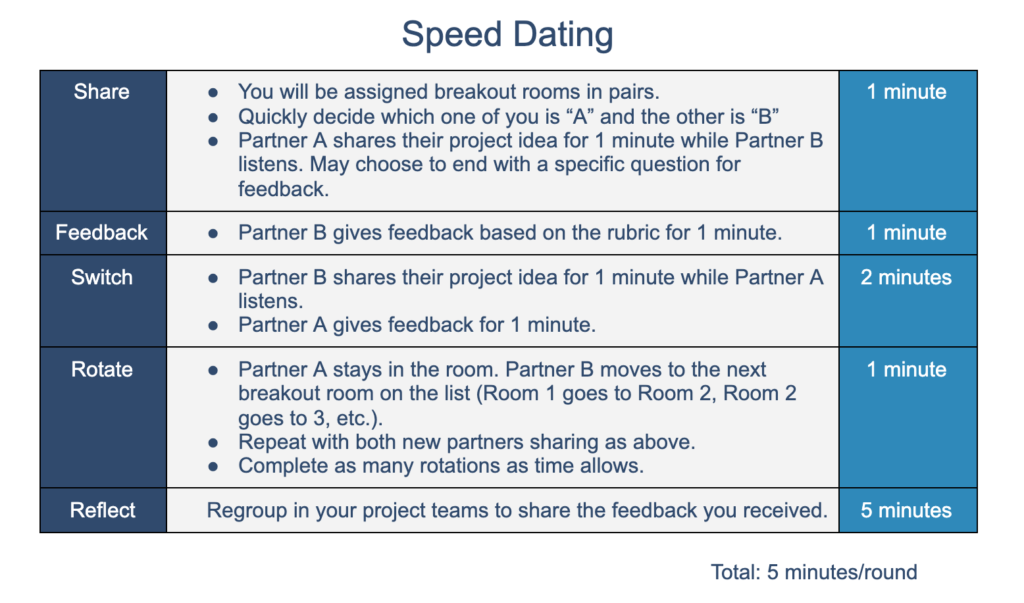
Speed Dating is a quick protocol for simple feedback early in the PBL process. You should emphasize that the teacher will be the timekeeper and broadcast the steps so that students know when to shift turns and rooms. Next the teacher creates enough breakout rooms for student pairs. When creating rooms it is critical that students can choose their own rooms (“Let participants choose room” in Zoom) so that they can rotate after each round.
But the teacher should designate where students go for the first round so that each room has a pair in it. Divide up students so that they are not in the same room as their project team members. You could post assigned rooms and partners ahead of time in a document, or you could simply call out pairs of student names on the screen and assign them to a specific room.
Time the protocol and broadcast messages to switch partners and rooms when time. Jump into rooms to monitor or help students who are confused with the directions, especially when switching rooms for the first time. Run as many rounds as you have time for. I like to do 3-5 rounds.
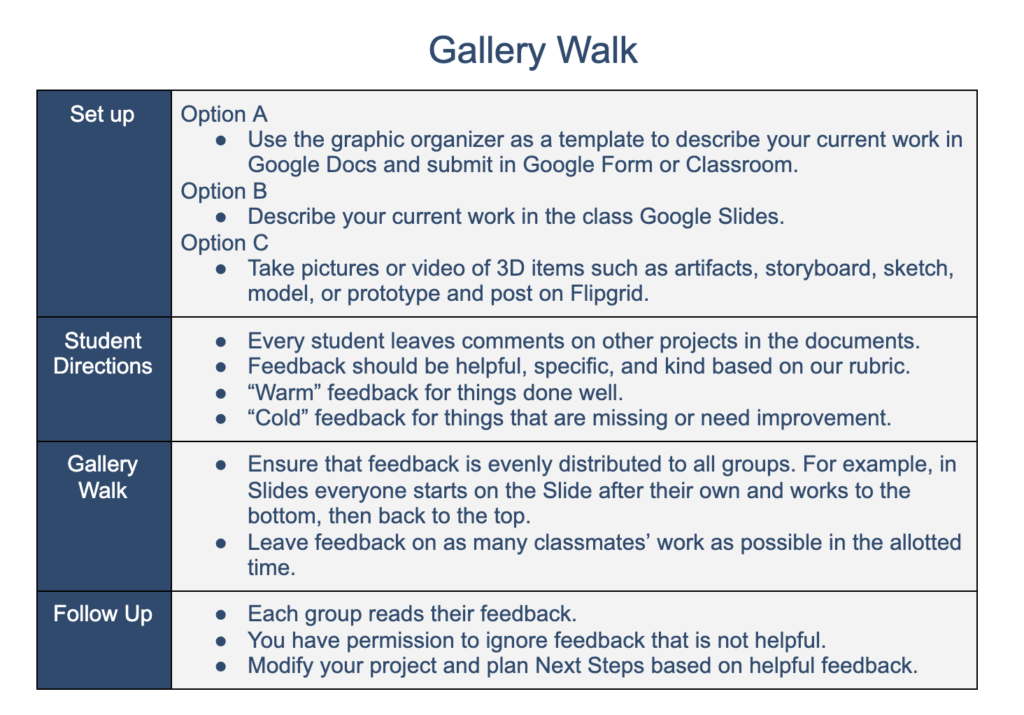
Gallery Walks are excellent for students to analyze each other’s work. First determine where online you want it posted. The slide gives three options. Be sure to use a tool that can be shared and that allows either written (Google Docs or Slides) or video feedback for comments (Flipgrid). The biggest hangup to avoid is making sure all students have access to each other’s work and commenting rights.
Consider showing Austin’s Butterfly as an example of what effective feedback looks like. I also recommend that students refer to rubric criteria to base their feedback on. Gallery Walks can be done “live” during synchronous time or spread out over a few days (set a deadline).
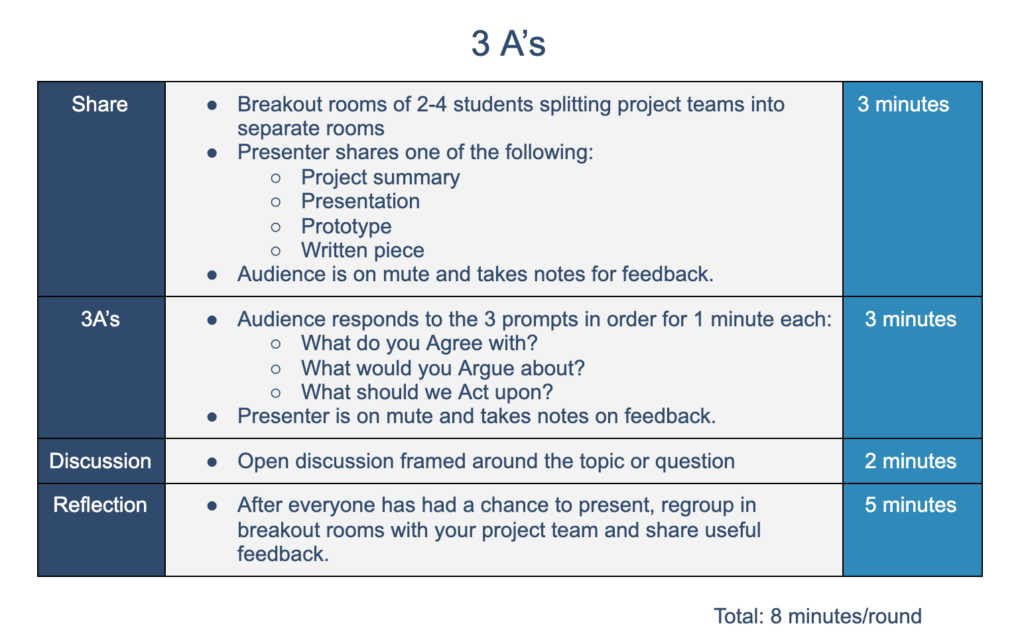
3 A’s is often used to analyze text, but can be great for feedback too. For feedback on a written document this could be done with comments in an online document.
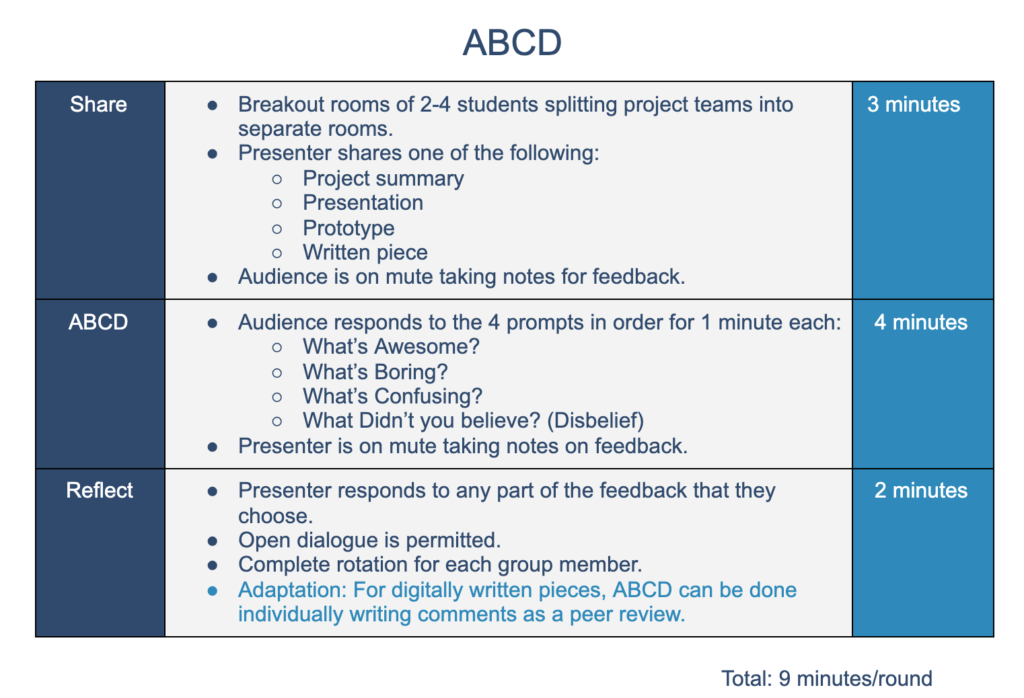
ABCD Protocol comes from the editorial world when proofing submissions. It can be used asynchronously with comments on written work or live feedback on presentations, prototypes, or other items.
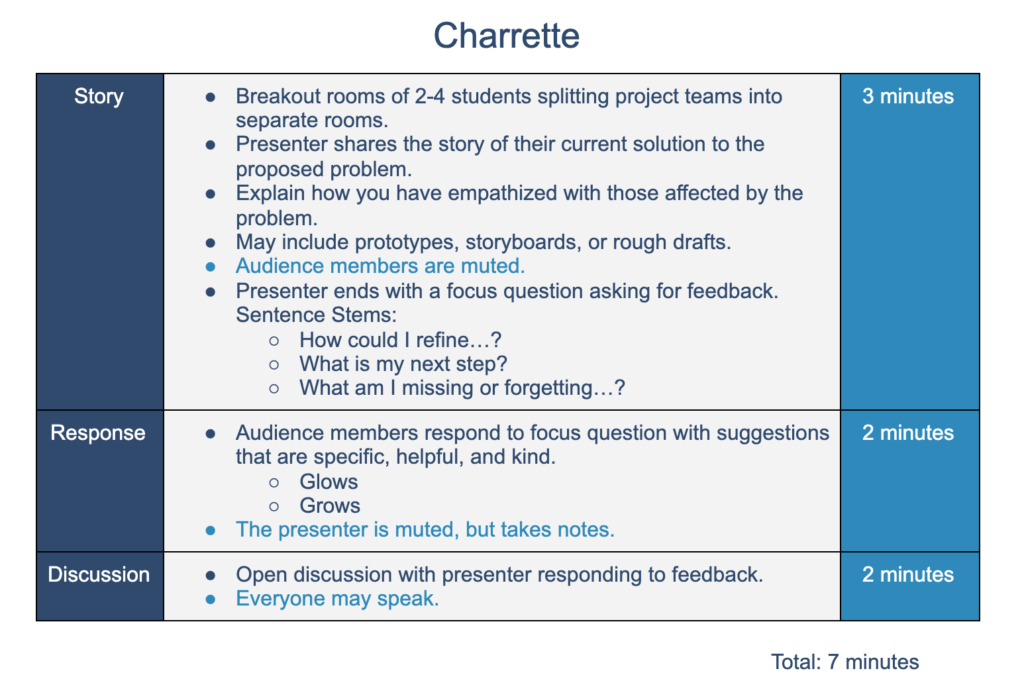
Charrette is an excellent protocol for the middle of a project to get feedback on Next steps. It’s informal and efficient.
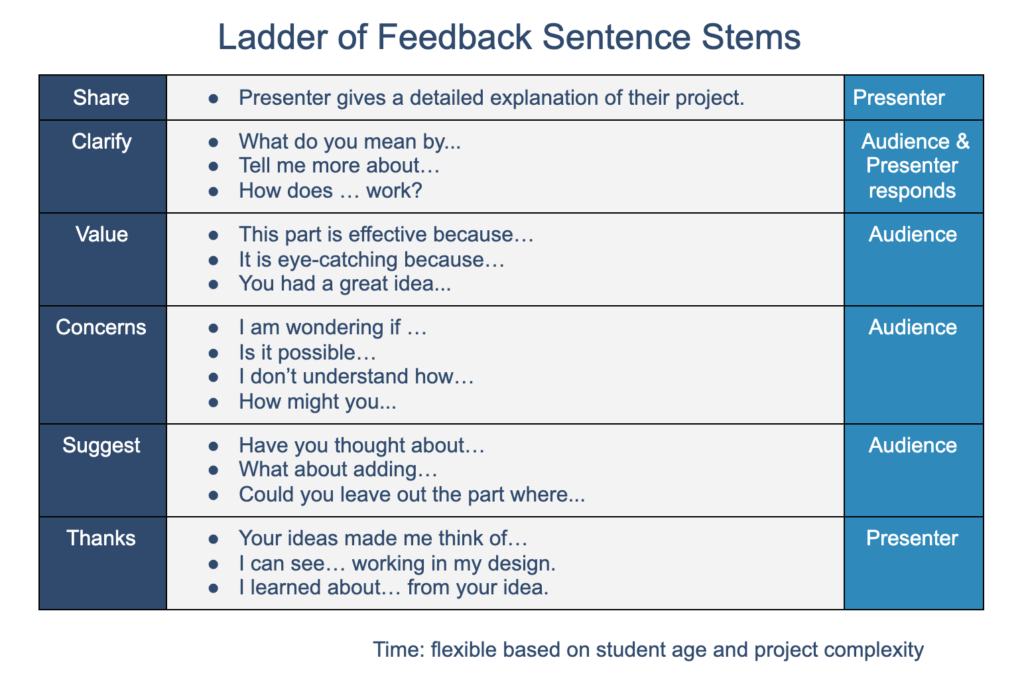
Ladder of Feedback is an alternative to the Tuning Protocol and is useful towards the end of a project for in-depth feedback. This slide contains only the student facing steps and sentence stems.
Split project teams into groups of 3 in breakout rooms. The teacher should be the timekeeper and broadcast when to shift to each step. After running 3 rounds so everyone can share, regroup students in their project teams to share feedback received.
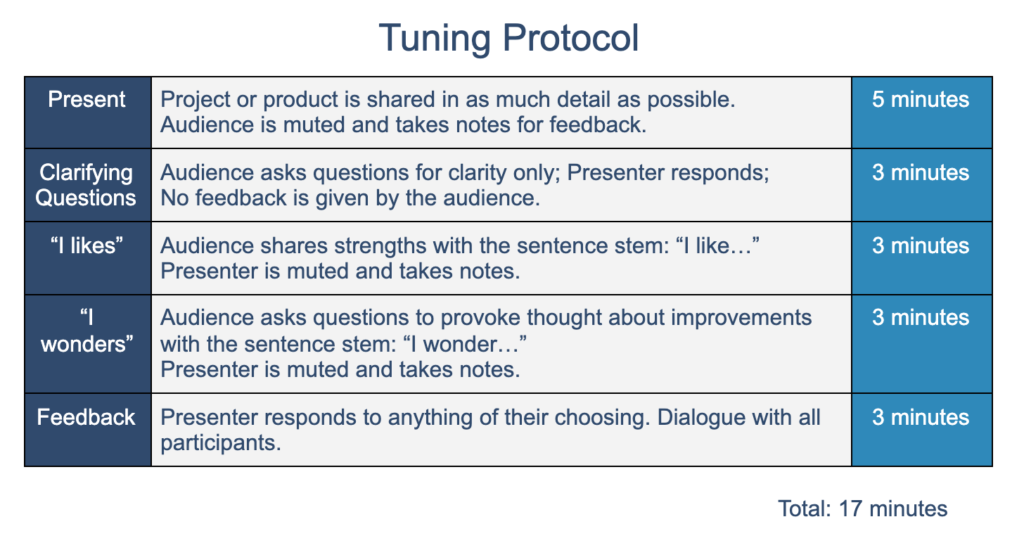
Like the Ladder of Feedback, the Tuning Protocol is a robust protocol for final feedback. As above, split project teams into groups of 3 in breakout rooms. The teacher should be the timekeeper and broadcast when to shift to each step. After running 3 rounds so everyone can share, regroup students in their project teams to share feedback received.
Questions? Interested in an SEL infused PBL workshop or consulting? Connect with me at michaelkaechele.com or @mikekaechele on Twitter.

